The Function Of Insect Exterminators In Environmental Sustainability
The Function Of Insect Exterminators In Environmental Sustainability
Blog Article
https://www.sonomanews.com/article/opinion/letters-to-the-index-tribune-editor-jan-25-2023/ Composed By-Bjerg Balslev
You might assume that pest exterminators are only interested in eliminating parasites, but their role exceeds that. They play a critical component in ecological sustainability.
By utilizing integrated pest management methods, they not only get rid of pests yet also secure biodiversity.
Furthermore, they use sustainable parasite extermination techniques to minimize environmental dangers.
So, next time you wonder about the value of pest exterminators, remember their contribution to a greener and healthier planet.
The Significance of Integrated Pest Management
You should understand the relevance of incorporated insect management in maintaining a lasting environment.
Integrated Parasite Management (IPM) is a strategy that focuses on stopping and managing bugs while lessening using hazardous chemicals. By implementing IPM techniques, you can successfully take care of bug populaces without triggering damage to the environment.
One crucial facet of IPM is making use of organic controls, such as killers and parasites, to naturally control pest populaces. This reduces the demand for chemical pesticides, which can have harmful results on wildlife and ecosystems.
Furthermore, IPM promotes the use of social and physical controls, such as plant turning and exemption techniques, to stop bugs from ending up being a trouble to begin with.
Safeguarding Biodiversity With Bug Control
We can secure biodiversity with reliable insect control methods that focus on the conservation of all-natural ecological communities. By employing responsible parasite control techniques, we can secure and maintain the fragile balance of varieties within our atmosphere. Right here are 3 ways in which insect control adds to protecting biodiversity:
- ** Protecting indigenous vegetation and fauna ** - By targeting invasive varieties that endanger indigenous plants and animals, bug control aids guarantee the survival of native species and keeps the all-natural diversity of environments.
- ** Protecting against the spread of illness ** - Controlling bugs such as insects and ticks reduces the threat of diseases infecting wildlife populaces, protecting biodiversity and preventing possible episodes.
- ** Conserving threatened species ** - By handling insects that victimize or take on endangered species, bug control initiatives can improve the opportunities of survival and advertise the healing of prone populaces.
With accountable insect control strategies, we can proactively add to the preservation of biodiversity and the sustainability of our environment.
Mitigating Environmental Risks With Sustainable Insect Elimination Approaches
By utilizing lasting insect extermination approaches, you can effectively reduce ecological dangers while ensuring the safety and well-being of both people and the natural community. Conventional parasite control methods commonly include the use of hazardous chemicals that can have harmful effects on the environment.
Nonetheless, sustainable bug elimination methods focus on decreasing these threats by utilizing environmentally friendly choices. For instance, integrated pest management (IPM) strategies focus on using safe and biodegradable items, along with natural killers to regulate pest populaces. This strategy not only minimizes the negative influence on the setting but likewise aids to maintain the delicate balance of the ecosystem.
Additionally, lasting parasite extermination methods promote the preservation of biodiversity by targeting details parasites without damaging advantageous microorganisms. By taking on these methods, you can add to a much more lasting and environmentally friendly technique to pest control.
Government regulations are the pest exterminator, the guardian of nature's harmony. With integrated bug administration, you balance the fragile ecosystem, making certain the survival of diverse varieties.
Via sustainable methods, you mitigate environmental threats, keeping the fragile balance intact.
Like a harmony conductor, you manage the rhythm and flow, securing the biodiversity that dances in excellent consistency.
With every action you take, you develop a globe where nature prospers, where pests retreat, and where sustainability preponderates.
